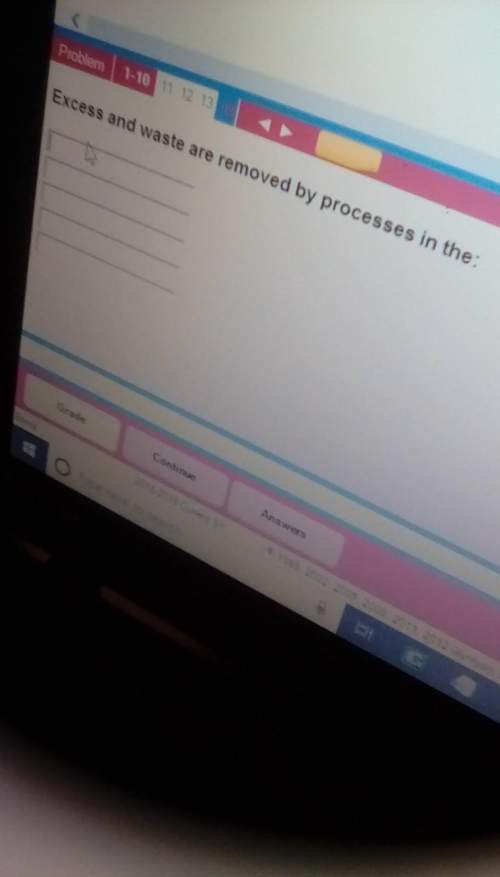HELP PLEASE
Question 1 (1 point)
Saved
What is the purpose of a model?
Question...

Biology, 18.11.2020 22:40 jodonw5616
HELP PLEASE
Question 1 (1 point)
Saved
What is the purpose of a model?
Question 1 options:
Increase the efficiency of cells
Representing things which would be difficult to observe directly
Recreate complex systems in a new location
Demonstrate the exact function of a living system
Question 2 (1 point)
Saved
Where in the cell does glycolysis occur?
Question 2 options:
Chloroplast
Mitochondria
Cytoplasm
Thylakoid
Question 3 (1 point)
Saved
Pyruvate has carbon (s) and is produced by
Question 3 options:
3, glycolysis
3, photosynthesis
4, glycolysis
6, photosynthesis
Question 4 (1 point)
Saved
What is NOT a product of glycolysis?
Question 4 options:
Oxygen
NADH
ATP
Pyruvate
Question 5 (1 point)
Saved
What is the benefit of oxidative phosphorylation over glycolysis?
Question 5 options:
Much more ATP produced
No membrane required
No special organelle required
Produces oxygen
Question 6 (1 point)
Saved
Why does photosynthesis require 38 ATP to make sugar but respiration only creates around 32 ATP?
Question 6 options:
Plants need more energy for building cell walls than animals do for respiration
Useful energy is lost during each chemical change
The sugar made from photosynthesis has more energy than the type of sugar used for respiration
All of the above
Question 7 (1 point)
Saved
Where would a concentration gradient exist?
Question 7 options:
Within the Cell wall
Throughout the Cytoplasm
Within the mitochondria
Outside the chloroplast
Question 8 (1 point)
Saved
How many times do you need to identify a loss of energy due to the second law of thermodynamics in your model?
Question 8 options:
Once
Twice
Every time it occurs
Never
Question 9 (1 point)
Saved
What creates the ATP in respiration?
Question 9 options:
Carbon dioxide
Light
Oxygen
ATP synthase
Question 10 (1 point)
Saved
What is the "job" of oxygen in respiration?
Question 10 options:
Pick up electron from electron transport chain
Split glucose into two pyruvate
Add "P" group onto ATP to make ADP
Phosphorylate NADH

Answers: 2


Another question on Biology

Biology, 21.06.2019 22:00
Fan egg cell containing the (n+1) number of chromosomes combines with a sperm cell containing the (n) number of chromosomes, what is the result of this union? a) all future somatic cells of the organism will contain the (2n + 1) number of chromosomes. b) all future somatic cells of the organism will contain the (2n - 1) number of chromosomes. c) only certain somatic cells of the organism will contain the (2n + 1) number of chromosomes. d) all future somatic cells of the organism will contain the normal diploid number of chromosomes.
Answers: 2

Biology, 22.06.2019 01:30
All individuals have two alleles for a given trait. according to mendel's these alleles are passed down one each from both mother and father.
Answers: 1

Biology, 22.06.2019 08:30
Anormal appearing couple is found to be heterozygous recessive for albinism both have the genotype aa the gene responsible for albinism is recessive to the normal pigment-producing gene what are the changes of their children being albino
Answers: 2

Biology, 22.06.2019 08:40
What best explains whether bromine (br) or neon (ne) is more likely to form a covalent bond? bromine forms covalent bonds because it has seven valence electrons, but neon has eight valence electrons and already fulfills the octet rule. bromine forms covalent bonds because it has many electron shells, but neon has only two electron shells and is tightly bound to its electrons. neon forms covalent bonds because it can share its valence electrons, but bromine has seven valence electrons and can gain only one more electron. neon forms covalent bonds because it has only two electron shells, but bromine has many electron shells and will lose electrons in order to fulfill the octet rule.
Answers: 3
You know the right answer?
Questions


History, 25.09.2019 05:30

Mathematics, 25.09.2019 05:30

Mathematics, 25.09.2019 05:30

Mathematics, 25.09.2019 05:30



Physics, 25.09.2019 05:30

Biology, 25.09.2019 05:30

History, 25.09.2019 05:30

Social Studies, 25.09.2019 05:30




Mathematics, 25.09.2019 05:30


English, 25.09.2019 05:30


Geography, 25.09.2019 05:30

Mathematics, 25.09.2019 05:30




